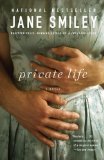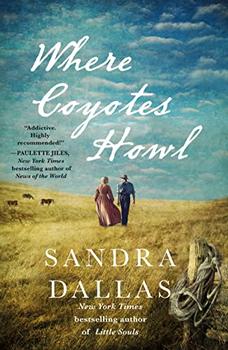Summary | Excerpt | Reading Guide | Reviews | Beyond the book | Read-Alikes | Genres & Themes | Author Bio

 Jane Smiley's characters are what make Private Life a novel to read more than once. Her style is not showy – you might call her a "good plain American prose stylist" the way you would call someone a "good plain cook." Her plotting is not full of confusing turns or big reveals or romantic yielding. But her characters are masterful constructions, as intelligent and surprising as real people can be.
Jane Smiley's characters are what make Private Life a novel to read more than once. Her style is not showy – you might call her a "good plain American prose stylist" the way you would call someone a "good plain cook." Her plotting is not full of confusing turns or big reveals or romantic yielding. But her characters are masterful constructions, as intelligent and surprising as real people can be.
Although Private Life isn't being marketed as a "retelling" of George Eliot’s Middlemarch, the way A Thousand Acres was billed as a modern King Lear, Smiley is clearly drawing on the legacy of George Eliot here. (Eliot hasn’t come up in the publicity surrounding Private Life yet, but Smiley has said in the past that Middlemarch is her favorite novel, and she writes extensively about it in Thirteen Ways of Looking at the Novel, published in 2005.) Eliot is English literature's patron saint of complex characters. Private Life recasts the central relationship in Middlemarch, the marriage between the dry scholar Casaubon and his bright young bride, Dorothea – here the scholar is the misguided astronomer Captain Andrew Early, and the bookish young wife is Margaret. As Eliot does in Middlemarch, Smiley places the personal story of the marriage against a backdrop of sweeping historical change. Where Eliot considered the coming of the railroad and the passage of the Reform Bill in early nineteenth century Britain, Smiley observes the onslaught of the twentieth century in Northern California – the San Francisco earthquake, the World Wars, Japanese internment camps, and women's liberation.
Margaret Early, née Mayfield, is the novel's seeing eye. Indeed, the narrative is so closely linked to her perspective, it becomes clear that the novel's sharp observations of character come from Margaret's own mind and not from an outside narrator. She has an astute self-awareness, even of her youthful naiveté, and registers the complexity in every person and every situation. It is Margaret who perceives what her future brother-in-law is thinking when her rich grandfather has a fainting spell in hot weather; it is Margaret who sketches the character of a newborn baby as engaged in a struggle with the "life force" (in one of the most beautiful and heart-wrenching passages in the book). When Margaret meets her husband-to-be for the first time, alarm bells go off (he's strangely antisocial and self-absorbed; he doesn't feel the cold), even as she sees his appeal. He's intellectual; he's intense; he's not your typical Missouri middle-class rural male. She's already read about him in the newspaper, and although she is too discerning to be swept off her feet, she is curious.
As the novel progresses, the characters never slip into black and white. The marriage is not a happy one, but its wrongness builds slowly and subtly. Andrew Early doesn't suddenly cross a line which makes the marriage untenable or his scientific ideas complete madness. Rather, the shades of complexity in the relationship and in his personality calcify. The flexibility of youth hardens; the character traits which were already in place become exaggerated to the point of extremity. Margaret's choices in life become more extreme too. The qualified optimism of the bride shades into the embittered passivity of the long-suffering wife, but even when things are at their worst, Margaret can always see her husband's side.
Modernism hovers in the background here. Even in rural Missouri, where Margaret spends her girlhood, books by local St. Louis daughter Kate Chopin turn up. And Smiley offers another vision of what might have been for Margaret in the form of her cousin, Dora (perhaps a play on "Dorothea"). Dora has no trouble shucking off the nineteenth century – she is an intellectual on her own terms right from the start. She rides a bike; she wears eccentric clothing; she makes a literary career for herself and hobnobs with all the cultural lights of the day. But there were far fewer Doras than Margarets in history, and so Margaret's story is more relevant and interesting.
Smiley uses her exquisite characters to comment on the passage of time, to provide a human-scale witness to a cataclysmic period in history. Margaret's self-awareness makes it possible to imagine what living through historical events might have been like. Margaret remarks, as the horrific events of the start of World War I are unfolding day by day, that she "could not help seeing the whole thing as the wreck of her own life and her own plans." A historical novelist has two choices, to show how strange and foreign another time is, or to demonstrate that the past was actually not unlike the present. Smiley comes closer to the second path, sometimes relying on Victorian clichés to fill out her image of the nineteenth century – one character has "luxuriant" hair, another "spidery" handwriting. But the main thrust of her project is to connect the dots from Victorian times to modernity in such a way that we can see what a great gulf is being crossed (from Aether to the Atomic Age) at the same time we discover how the present is a product of the past. Andrew Early's job is to keep the Navy's chronometers on a precise, standardized time. Margaret marks time in a different way, watching and remembering.
![]() This review was originally published in The BookBrowse Review in May 2010, and has been updated for the
August 2011 edition.
Click here to go to this issue.
This review was originally published in The BookBrowse Review in May 2010, and has been updated for the
August 2011 edition.
Click here to go to this issue.

If you liked Private Life, try these:

by Sandra Dallas
Published 2024
Beautifully rendered, Where Coyotes Howl is a vivid and deeply affecting ode to the early twentieth century West, from master storyteller Sandra Dallas.

by Jane Smiley
Published 2023
From the beloved Pulitzer Prize-winning and best-selling author of A Thousand Acres: a rollicking murder mystery set in Gold Rush California, as two young prostitutes follow a trail of missing girls.
These are not books, lumps of lifeless paper, but minds alive on the shelves
Click Here to find out who said this, as well as discovering other famous literary quotes!
Your guide toexceptional books
BookBrowse seeks out and recommends the best in contemporary fiction and nonfiction—books that not only engage and entertain but also deepen our understanding of ourselves and the world around us.